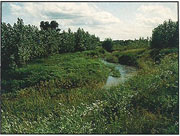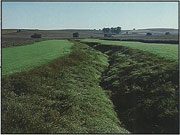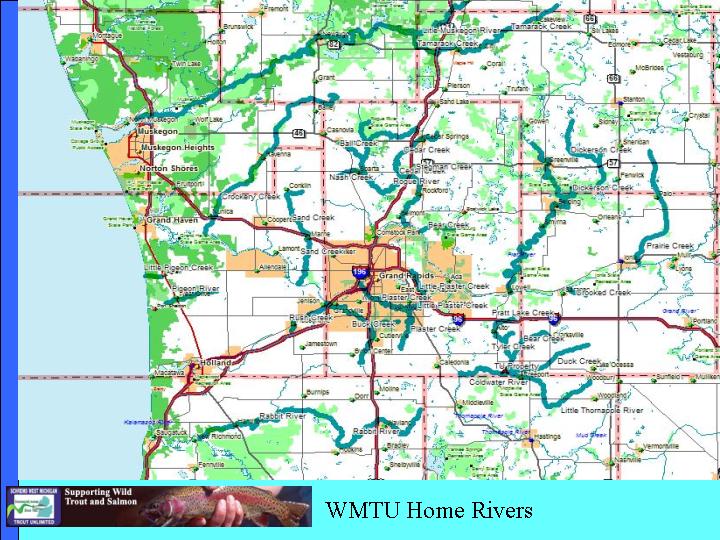What you can do to protect our lakes and streams
What is a Riparian Area?
Riparian zones or areas have been defined in several ways, but they are essentially the narrow strips of land that border creeks, rivers or other bodies of water. Because of their proximity to water, plant species and topography of riparian zones differ considerably from those of adjacent uplands. Although they comprise a small proportion of the total landscape, they are among the most diverse biological systems on earth, and they perform important services to people which no amount of human effort and technology can do as well.
Functions of a Healthy Riparian System
1. Sediment Filtering
2. Bank Stablilization
3. Water Storage and Release
4. Aquifer Recharge
A healthy, functioning riparian area and associated uplands dramatically increase benefits such as fish and wildlife habitat, erosion control, forage, late season streamflow, and water quality.
An unhealthy system would have some or all these characteristics:
1. Low water table and decreased storage capacity,
2. Low forage production for fish and wildlife,
3. Little shade-Warm water,
4. Poor fish habitat-Poor water quality,
5. Low wildlife habitat diversity
6. Little vegetation & roots to help protect and stabilize banks,
7. Significant erosion of streambanks and shorelines
8. Repeated dredging of ditches, streams, and resevoirs
9. Reduced late summer stream flows.
10. Decreased riparian property values.
A healthy system would have the opposite of these characteristics.
Riparian Protection for Homeowners
Residents of Michigan enjoy a unique environment. Carved out by retreating glaciers thousands of years ago, the Great Lakes, along with the thousands of smaller lakes, rivers, and streams, were formed. Traditionally, a lush green carpet of turf grass from one edge of your property to the other is the ultimate goal, but have you considered the impact of this on our environment? We precisely sow a tight field of grass that is difficult to coax into growing, ply it with fertilizer, spray it with pesticides, water it till it finally takes hold and grows. Then, just as the plants are healthy and happy, we cut of the top third and it has to struggle all over again. Significant ecological improvements can be made by home-owners, both in and outside of riparian areas through landscaping for water quality.
Landscaping for Water Quality
Why Landscape for Water Quality?
- To Capture Rain Water. Protect Water Quality, Increase Infiltration Rates and Reduce Pollution: In natural areas, rainwater infiltrates into the soil almost completely. Many contaminates are filtered out by the soil before the water enters the surface or ground waters. In developed lots, typical turf grass compacts the soil as its roots form a three-inch thick dense mat which restricts water flow into the ground making it almost impervious to water infiltration. In a typical rainstorm 2/3 of the rain-water runs off your property rather than filtering through the ground and recharging the ground water. This run-off can carry fertilizers, pesticides, oils, and other contaminants into our surface waters.
- To Ease Soil Erosion and Reduce Flooding: With up to 2/3 of rain-water running off residential property, significant loss of topsoil and stream bank erosion can occur. Typical turf-grass roots only reach about three inches deep, too shallow to effectively restrict soil loss from flowing water. Deeper rooted plants such as native prairie plants and flowers with roots that grow from one to several feet deep are required to prevent erosion. By utilizing deeper rooted plants, water infiltration is increased and less surface run-off occurs leading to less flooding.
- To Enhance Property Values: Landscaping enhancement is a proven method of increasing the value of your property. Natural landscapes can also reduce annual maintenance costs through reduced water, fertilizer, herbicide and pesticide usage as well is reduction in mowing.
For more information check out the guide “Landscaping for Water Quality”
Programs for Assisting Homeowners
- Home*A*Syst: is a confidential, self-assessment program you can use to evaluate your home and property for pollution and health risks. The booklet is available from your local Michigan State University Extension office.
- Lawn*A*Syst: An environmental risk assessment guide for lawn care practices.
o Lawn*A*Syst Description
o Spring Lawn Care
o Summer Lawn Care
o Late Summer Lawn Care
o Other Lawn Care - MSUE Soil Nutrient Testing Service: Not sure of what type of fertilizer to apply or how often? Get your soil tested by Michigan State University’s County Extension office. Cost varies by county, but generally ranges from $9 to $9.50.
- List of MSU Extension Offices by County
- Department of Crop and Soil Sciences
- Kent County MSU Extension
836 Fuller Ave NE
Grand Rapids, MI 49503
Phone: (616) 336-3265 - Barry County MSU Extension
220 W. Court Street
Hastings, MI 49058
Phone: (616) 948-4862
- Sources of Michigan Native Plants – Growers and Landscapers
RIPARIAN PROTECTION FOR AGRICULTURAL
Michigan farmers have long played a key role in protecting the quality of our trout streams. Over 53% of Michigan’s land area is farmed, and farmers own nearly 7% of the total forest area in Michigan. If public forest areas are excluded, the percentage of forest covered lands owned by farmers increases to over 12.5%. These forests provide critical shade and habitat to many of our trout streams in Michigan. The increase in CAFO’s (Concentrated Animal Feeding Operations) has brought both positive and negative effects to our rivers and streams. On the positive side, CAFO’s are more effective at keeping cattle out of our streams and the ensuing stream bank erosion. On the negative side, the concentration of animals raises the risk level for ecological damage to surface waters and trout streams from their waste products. In order to best protect our streams and lakes, several conservation practices will be needed. For instance, a system of residue management in combination with buffer strips and grassed waterways will be more effective than residue management alone.
The Value of Buffers
One of the critical systems for protecting our lakes and streams from agricultural run-off is the use of buffer strips. Buffer strips include plantings of trees, shrubs, and deep- rooted grasses to slow water runoff, and trap pollutants such as fertilizers, pesticides, bacteria, pathogens, and heavy metals before they can reach surface or ground water sources. Buffers also trap snow and reduce blowing soil in areas with strong winds. Riparian buffers also improve fish and wildlife habitat. Some buffers, particularly wooded buffers, can even provide a future source of income.
Riparian Buffer Strips
 The Stream Side Forest Buffer is generally designed in 3 zones. Zone 1 is the area closest to the stream or water body and it ideally consists of mature trees to provide detritus to the stream and to provide shade to maintain lower stream temperatures and an extensive root system to prevent erosion. Zone 1 is generally left undisturbed. Zone 2 is the managed forest section where filtration, deposition, plant uptake and other natural processes remove sediment and nutrients from runoff and subsurface flows. Zone 3 is where concentrated flows are converted to dispersed flows by water bars or spreaders to facilitate ground contact and infiltration. A diagram of a typical stream side forest buffer can be found here: The Stream Side Forest Buffer Layout
The Stream Side Forest Buffer is generally designed in 3 zones. Zone 1 is the area closest to the stream or water body and it ideally consists of mature trees to provide detritus to the stream and to provide shade to maintain lower stream temperatures and an extensive root system to prevent erosion. Zone 1 is generally left undisturbed. Zone 2 is the managed forest section where filtration, deposition, plant uptake and other natural processes remove sediment and nutrients from runoff and subsurface flows. Zone 3 is where concentrated flows are converted to dispersed flows by water bars or spreaders to facilitate ground contact and infiltration. A diagram of a typical stream side forest buffer can be found here: The Stream Side Forest Buffer Layout
A second type of buffer zone is the Filter Strip. This consists of strips of grass used to trap sediment, fertilizers, pesticides, and other pollutants before they reach streams and lakes. In planting filter strips, it is best to use deep-rooted grasses to improve water infiltration.
Creating Buffer Zones
 The Value of Buffers and Various Types of Buffers
The Value of Buffers and Various Types of Buffers
Filter Strips
Riparian Forest Buffer
Wetland Restoration
Native Grass Planting
Residue Management
Depending upon the species of animal, 70-80% of the Nitrogen (N), 60-85% of the Phosphorus (P) and 80-90% of the potassium (K) fed to the animals as feed will be excreted in the manure. Livestock operations can generate large amounts of manure and increase the challenge and risks of recycling manure nutrients for crop production without causing these same nutrients to be introduced into local streams. It has been estimated that a large CAFO can produce as much sewage as a city of 100,000 people. The U.S. Environmental Protection Agency lists manure runoff from farms as one of the leading causes of water pollution in the United States. What can be done to prevent manure spills or runoff? The Michigan Department of Agriculture has developed Generally Accepted Agricultural Management Practices (GAAMP) which farmers should use to operate as safely as possible.
Michigan Generally Accepted Agricultural Management Practices (GAAMP)
- Manure Management/Utilization GAAMP
- Pesticide Utilization/Pest Control GAAMP
- Nutrient Utilization GAAMP
- Care of Farm Animals GAAMP
Programs for Assisting Farmers / Dairies with Conservation
- Conservation Reserve Enhancement Program (CREP): Michigan’s Conservation Reserve Enhancement Program (CREP) was created to help protect our environment and wildlife. Michigan is partnering with the federal government to implement conservation practices of great significance to the state, and valuable to the nation, in matters of soil erosion, water quality, and wildlife habitat. In Michigan’s CREP, farmers and other landowners in priority watershed areas agree to enroll eligible parcels of land in the program for 15 years, and establish prescribed conservation practices. In return, landowners receive cost-share assistance in establishing conservation practices. Approved practices include riparian buffers, field windbreaks, filter strips, wetland restoration, shallow-water wildlife areas, controlled livestock access and conservation easements. Currently the priority areas include the Lake Macatawa, River Raisin, and Saginaw Bay Watersheds. For more information, see the CREP Web Site.
- Michigan Groundwater Stewardship Program: Its purpose is to provide information and assessment tools for pesticide and nitrogen fertilizer users which help them identify risks to groundwater associated with their pesticide and nitrogen fertilizer use practices and to coordinate local, state, and federal resources to help individuals reduce those risks. The Michigan Groundwater Stewardship Program is designed to be voluntary, to be locally driven, to address the concerns of individuals, and to maintain a focus on the financial and technical constraints which drive real world decisions.
- Michigan Agriculture Environmental Assurance Program (MAEAP): MAEAP is an innovative, proactive program that helps farms of all sizes and all commodities voluntarily prevent or minimize agricultural pollution risks. MAEAP teaches farmers how to identify and prevent environmental risks and comply with state and federal environmental regulations. Farmers who successfully complete the three phases of a MAEAP system are rewarded by becoming verified in that system.MAEAP was developed by a coalition of agriculture producers, commodity groups, state and federal agencies, and conservation and environmental groups. While the Michigan Department of Agriculture (MDA) is the verifying agency, MAEAP is not a government or regulatory program but rather a partnership effort.
- MAEAP Web Site
Links
Manure and Nutrient Management – MSUE
MSU Soil & Plant Nutrient Laboratory
Michigan Generally Accepted Agricultural Management Practices (GAAMP)
Manure Management/Utilization GAAMP
Pesticide Utilization/Pest Control GAAMP
Nutrient Utilization GAAMP
Care of Farm Animals GAAMP
Michigan Conservation Reserve Enhancement Program (CREP)
Creating Buffer Zones:
Filter Strips
West Michigan Trout Streams (Home Waters of SWMTU)

Other Links for Riparian Protection
Drinking Water
–EPA Drinking Water Standards
–Testing Private Well Water
General Yard Care
–Riparian Owner’s Guidebook
–Managing Shoreline Property to Protect Water Quality
–Composting Information
–Rain Gardens Information
–Landscaping for Water Quality
–Natural Enemies in Your Garden: A Homeowner’s Guide to Biological Control
–MSU Turf Tips
–Yard Care and the Environment
–Buffer Strips Along Riparian Areas
–Buffer Strips Along Riparian Areas
Fertilizers & Pesticides
–Slow Release Fertilizers
–Zero Phosphorus Fertilizers
–Phosphorus and Home Lawns
–Soil Testing
–USGS Study on Pesticide Occurrence in Nation’s Streams
–Pesticide Protection
–Reading a Pesticide Label
–Safe Pesticide Storage
–Pesticide Application
–Toxicological and Environmental Information about Pesticides
Septic Systems
–Septic System Owner’s Guidebook
–A Homeowner’s Guide to Septic Systems
Other Local Organizations:
WMEAC (West Michigan Environmental Action Council)
1514 Wealthy SE #280
Grand Rapids, MI 49506
Phone: (616) 451 3051
Web Site: http://www.wmeac.org/
Barry Conservation District
1611 S. Hanover #105
Hastings, MI 49058 Phone: (616) 948-8056

